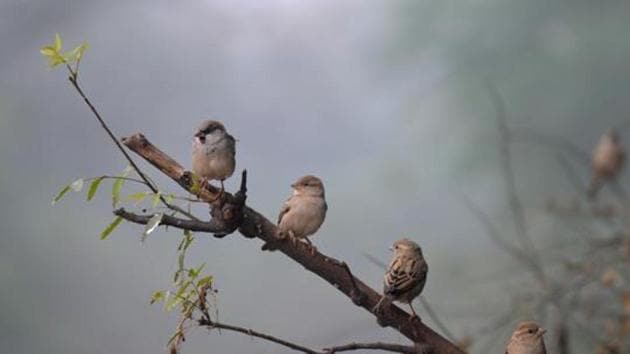Report shows population on decline across bird species
Data from six cities --Bengaluru, Chennai, Delhi, Hyderabad, Kolkata and Mumbai —- indicates a gradual decline in their abundance in urban centres.
The House Sparrow, which was thought to be disappearing from towns and cities, may not be as threatened as believed, a new analysis has found. That good news, though, is offset by the fact that around half of 261 Indian bird species studied have seen a decline in numbers since 2000, with a fifth seeing a sharp decline.

The report titled “State of India’s Birds 2000” based on around 10 million observations contributed by over 15,500 birdwatchers to an e-Bird, an online bird registry that’s widely used by birdwatchers suggests that the House Sparrow’s numbers have been fairly stable overall during the past 25 years.
However, data from six cities --Bengaluru, Chennai, Delhi, Hyderabad, Kolkata and Mumbai —- indicates a gradual decline in their abundance in urban centres. “Extremely large range of the species (House Sparrow) across the country, and the lack of evidence for either long-term or current countrywide decline results in it being classified as of low conservation concern,” said the report, which was released on Monday at the thirteenth conference of parties of the Convention on Conservation of Migratory Species.
Feral Pigeons, which dominate the urban landscape in many cities have seen a rise in numbers in the past 25 years, as have Peafowls.
“We did not have country level data so far to understand this. The data contributed by citizen scientists is of a quality which I as a biologist cannot collect across the geography and across years,” said Suresh Kumar from Wildlife Institute of India, who also worked on the report.
The report, apart from capturing interesting trends in change in population of common species rings alarm bells on the large scale decline of important bird species.
It analysed the status of 867 bird species using data uploaded by bird watchers (by location, and, in some cases, with numbers) and made assessments based on three indices: long-term trend of observations over 25 years; current annual trends over the past five years; and distribution or range size.
Of the 261 species for which long-term trends are available 52% have seen a decline in numbers since 2000, with 22% declining strongly. In all, 43% of species showed stable numbers and 5% showed an increasing trend.
“In India, the decline could be because of habitat loss, but there could also be several other reasons. Our understanding of it is very poor. There could also be some disease outbreak we do not know about. We came to know of the association in the declining population of vultures and veterinary diclofenac use after years. There could be some similar issues. What this data does is direct us that a particular species is on decline and analyse why it is happening,” said Kumar.
Diclofenac, a drug used on cattle, was found to be toxic for vultures.
Current annual trends could be estimated only for 146 species for which data is available. Of those, nearly 80% are declining, 6% are stable and 14% are increasing.
The groups that show the greatest decline are raptors (birds of prey), migratory shorebirds, and habitat specialists (confined to some habitats), among others including White-rumped Vulture, Richard’s Pipit, Indian Vulture, Large-billed Leaf Warbler, Pacific Golden Plover and Curlew Sandpiper. The overall decline in species demands research into the causes, and action to protect the high concern species, the report said.
Species that show an increasing trend in the past 25 years include Rosy Starling, Feral Pigeon, Glossy Ibis, Plain Prinia, Ashy Prinia, and Indian Peafowl.
Interestingly, of the species in the high category of conservation concern for India, 26% (26 species) are classified as globally of "least concern” by the IUCN Red List 2019. But 7 species considered globally “near threatened” or “vulnerable” are classified as being of low concern in India through this assessment. These are: Ferruginous Duck, Black-tailed Godwit, Woolly-necked Stork, Oriental Darter, Black-headed Ibis, Alexandrine Parakeet and Long-tailed Parakeet.
“IUCN makes a global assessment, this is India specific. There are some species that are doing fine globally but are rapidly declining in India. Also, BirdLife international, which carries out the global assessments for birds, says that they depend on information coming from different parts of the world, and for some species data are quite sparse. The information contained in this report is likely to get into the global assessments soon.” said Suhel Quader, scientist, Nature Conservation Foundation.
Among raptors, open country specialists show a particularly strong decline both in the long term and current trends as opposed to generalist and woodland raptors. Scavengers (mostly vultures) have been in severe decline over the past 25 years.
Around 12 species endemic to the Western Ghats are nearly 75% lower in abundance compared to 2000. Some threatened habitats like the grasslands of the Terai, which harbour the entire global population of the Hodgson’s Bushchat, require immediate attention, the report flagged.
“The report has described a pattern of change in population but not in distribution. Based on the broad patterns captured in the report we can now ask why a certain species has declined. We couldn’t have asked these questions before,” said MD Madhusudan, wildlife biologist and member of team that produced the report.
Nikhil Devasar, founder of Delhibird group said “Ebird is not used so much in north India but is very popular of south India. I wonder if its able to capture the trends accurately.”






